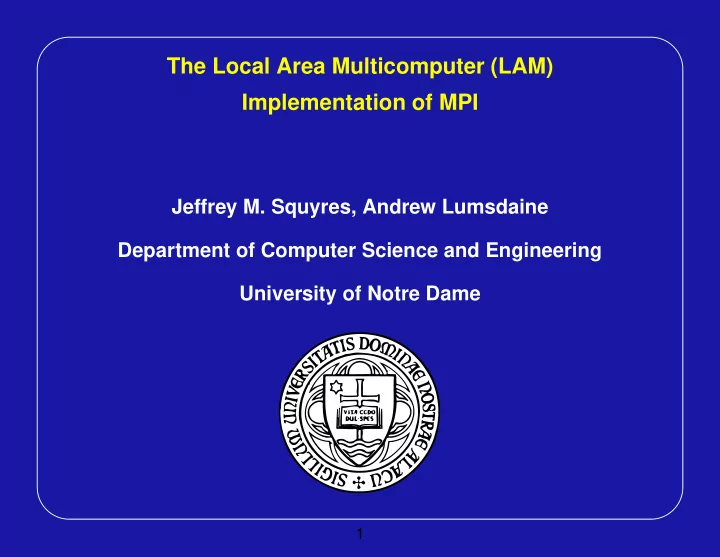

The Local Area Multicomputer (LAM) Implementation of MPI Jeffrey M. Squyres, Andrew Lumsdaine Department of Computer Science and Engineering University of Notre Dame 1
Overview � What is LAM/MPI? � Why would I use LAM/MPI? � How do I use LAM/MPI? � Where do I get LAM/MPI? � Future directions 2
What is LAM/MPI? � An independent implementation of the MPI standard � All of MPI-1 (except MPI CANCEL sent messages) � Much of MPI-2 � Originally developed at the Ohio Supercomputing Center – Now developed / maintained at the University of Notre Dame 3
MPI-2 Features � Dynamic processes � Most of one-sided communication � Most new MPI-2 datatypes � Many MPI-2 support functions � MPI-IO (from the ROMIO package) � C++ bindings for MPI-1 functions � Interoperable MPI (IMPI) point-to-point support 4
Usability Features � Persistent, daemon-based run-time environment � Visual debugging through XMPI � Supports SPMD and MPMD execution models � Pseudo-tty support (i.e., line-buffered output) � Can mpirun debuggers / scripts � Can be used with Purify and other memory-checking tools � Lots of documentation 5
“Cluster Friendly” � Guaranteed cleanup of user (runaway) processes � Fast mpirun startup, even across large numbers of hosts � SMP-aware mpirun syntax � Passing of environment to remote ranks � Works even in non-uniform filesystem environments � POSIX-like path semantics 6
Supported Architectures � Works on just about all POSIX architectures – Does not work under Windows – ...except under Cygwin � Supports heterogeneous environments � 64-bit clean 7
Overview � What is LAM/MPI? � Why would I use LAM/MPI? � How do I use LAM/MPI? � Where do I get LAM/MPI? � Future directions 8
Why would I use LAM/MPI? � It’s free! � Under continual development – We’re not just the developers, we’re users too – New research directions lead to better performance � Bunches of MPI-2 already implemented � Ability to mpirun scripts and arbitrary debuggers – We use this feature extensively to develop LAM itself 9
Cluster Friendliness � Integrated process management � Integrated fast mpirun startup Node n0 mpirun Node n1 User MPI fork fork User MPI LAM LAM program daemon daemon program Node n2 Node n3 User MPI fork fork User MPI LAM LAM program daemon daemon program 10
Even More Reasons � High performance – Transparent dual mode shared memory / TCP message passing – Optimized common-case send/receive – Optimized persistent mode send/receive � POSIX behavior for serial-like execution semantics 11
XMPI � Visualization of messgae passing 12
Overview � What is LAM/MPI? � Why would I use LAM/MPI? � How do I use LAM/MPI? � Where do I get LAM/MPI? � Future directions 13
How do I use LAM/MPI? � Three main steps: 1. Start the LAM/MPI run-time environment lamboot -v hostfile 2. Run user program(s) mpirun -np 4 program1 mpirun -np 8 program2 . . . 3. Shutdown the LAM/MPI run-time environment lamhalt 14
Compiling � “Wrapper” compilers take care of all necessary flags � Used just like “real” compilers C: mpicc foo.c C++: mpiCC bar.cc Fortran: mpif77 baz.f � Can change the underlying compiler setenv LAMHF77 f90 mpif77 baz.f 15
Process Management � lamclean : Clean up “runaway” processes – Most helpful when debugging parallel code – Especially if ˆ C, for some reason, doesn’t kill everything � mpitask : Check progress of MPI ranks TASK FUNC SRC TAG COMM CNT DTYPE 0/0 a.out Recv 1/1 1234 WORLD 1024 INT 1 a.out <run> � mpimsg : See pending messages on the network SRC DEST TAG COMM CNT DTYPE 1/1 0/0 4321 WORLD 1024 INT 16
Overview � What is LAM/MPI? � Why would I use LAM/MPI? � How do I use LAM/MPI? � Where do I get LAM/MPI? � Future directions 17
Where do I get LAM/MPI? � The main LAM web site is: http://www.mpi.nd.edu/lam/ � Also contained in the leading Linux and BSD distributions – RedHat – S.u.S.E. – Debian – BlackLab – LinuxPPC – OpenBSD 18
Additional Information / Documentation � The LAM FAQ contains much information about LAM, MPI, and typical cluster-based setups http://www.mpi.nd.edu/lam/faq/ � The LAM mailing list archives http://www.mpi.nd.edu/MailArchives/lam/ � To join the LAM mailing list, send mail to “ majordomo@mpi.nd.edu ” with “ subscribe lam ” in the body 19
Overview � What is LAM/MPI? � Why would I use LAM/MPI? � How do I use LAM/MPI? � Where do I get LAM/MPI? � Future directions 20
Future Directions � Myrinet and VIA “drivers” � Tighter integration with PBS � Improved shared memory performance � Full IMPI functionality � TotalView debugger support � Thread safety / thread concurrency � C++ bindings for MPI-2 functions � Fortran 90 module 21
Recommend
More recommend